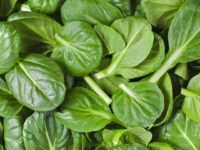Home » Vegetables
Growing Spinach in Your Garden

How to Grow Spinach Spinach is a green leafy crop that can be eaten either raw or cooked. A plate of cooked Spinach contains 41 calories, high levels of Vitamins A and K and other minerals including; Vitamin C (23.5%), Potassium (23.9%), Calcium (24.4%), Vitamin E (24.9%), Vitamin B6 (25.8%), Vitamin B2 (32.3%), Copper (34.4%), Iron (35.7%), Magnesium (35.1%), Folate (65.7%), and Manganese (84%). Spinach is less acidic than most vegetables and as such, it’s very recommendable to people of all ages. With the right climate conditions, Spinach takes less than two months to fully mature after planting. Spinach does well even when grown together with other crops like cabbages, cauliflower, broad beans, onions, strawberry; you name it Have a look at this essential guide on how to grow Spinach; When Best to Plant Spinach Planting should be done as soon as the warm weather sets in. The soil should be less than 70ºF (21°C) hot. Ensure you do the planting every two weeks during the warm season. How to Plant Spinach Ensure where you plant your Spinach has access to full sun and light shade and that the soil is well-drained. Use aged manure to prepare the soil about a week before the actual planting. Transplanting spinach seeds is not recommended so all the planting should be done in one place. Sow the spinach seeds about ½ inch to 1 inch deep then cover lightly with soil. Keep watering the new plants. How to Care for Spinach If your soil pH is inadequate, supplement it with fertilizer to avoid slow growth. After seedlings have sprouted to about 2 inches, reduce them by thinning to 3-4 inches apart. Spinach doesn’t require constant cultivation because its roots are shallow and can be easily damaged. Consider mulching as a way to keep the soil moist during hot seasons. Water the crops regularly Spinach can withstand cold weathers to some extent. Common Pests and Diseases that affect Spinach Leaf Miners Bolting Mosaic Virus / Blight Downy Mildew Harvesting Spinach Leaves Spinach takes around six weeks to fully mature. However, you harvest when the leaves reach to your desired size. If you wait for too long, the over matured leaves become hard and bitter when cooked. The whole plant bunch can be harvested at once by cutting at the base or picked one leave at a time hence allowing the inner layers some more time to develop. Varieties of Spinach Leaves Giant Nobel: this one comes in a plain leafy variety Winter Bloomsdale: it has crinkled leaf, is tolerant in case of mosaic viruses and fall variety. Tyee: It can be planted during fall or spring. It is highly resistant when it comes to downy mildew New Zealand Spinach (Tetragoniatetragonides) and Malabar Spinach (Basellaalba): These two types of Spinach are heat tolerant. They can be grown during summer when the heat is high and still do very well. Health Benefits of Eating Spinach Diabetes Management: Alpha-lipoic acid in Spinach lowers glucose levels and increases insulin sensitivity in diabetes patients. Cancer Prevention: Chlorophyll in spinach blocks carcinogenic effects generated when foods are grilled at high temperatures. This contributes a lot in preventing cancer growth. Asthma prevention: Beta Carotene in Spinach lowers the risk of developing asthma in children. Lowering Blood pressure: Potassium in Spinach reduces the effect of sodium in the body. Healthy hair and skin: the Vitamin A in spinach moderates oil in skin pores, together with hair follicles.
Read More »